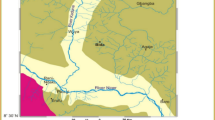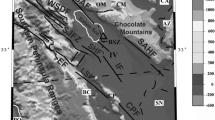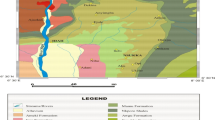Abstract
Aeromagnetic data were analyzed to determine the Curie point depth (CPD) by power density spectral and three-dimensional inversion methods within and surrounding Death Valley in southern California. We calculated the CPD for 0.5° regions using 2D power density spectral methods and found that the CPDs varied between 8 and 17 km. However, the 0.5° region may average areas that include shallow and deep CPDs, and because of this limitation, we used the 3D inversion method to determine if this method may provide better resolution of the CPDs. The final 3D model indicates that the depth to the bottom of the magnetic susceptible bodies varies between 5 and 23 km. Even though both methods produced roughly similar results, the 3D inversion method produced a higher lateral resolution of the CPDs. The shallowest CPDs occur within the central and southern Death Valley, Panamint Valley, Coso geothermal field and the Tecopa hot springs region. Deeper (>15 km) CPDs occur over outcropping granitic and Precambrian lithologies in the Panamint Range, Grapevine Mountains, Black Mountains and the Argus Range. The shallowest CPD occurs within the central Death Valley over a possible seismically imaged magma body and slightly deeper values occur within the Panamint Valley, southern Death Valley and Tecopa Hot Springs. The shallow CPD values suggest that partially molten material may also be found in these latter regions. The CPD computed heat flow values for the region suggest that the entire area has high heat flow values (>100 mW m−2), on the other hand, locally extremely high values (>200 mW m−2) occur within the Panamint Valley, the southern and central Death Valley and Tecopa Hot Springs region. These locally high heat flow values may be related to midcrustal magma bodies; but additional geophysical experiments are needed to determine if the magma bodies exist.












Similar content being viewed by others
References
Bankey, V., Cuevas, A., Daniels, D., Finn, C., Hernandez, I., Hill, P., Kucks, R., Miles, W., Pilkington, M., Roberts, C., Roest, W., Rystrom, V., Shearer, S., Snyder, S., Sweeney, R., Velez, J., Phillips, J., and Ravat, D. (2002), Digital data grids for the magnetic anomaly187 map of North America, U.S. Geological Survey Open-File Report 02-414, US Geological Survey, Denver, Colorado, USA.
Bhattacharyya, B. K., and Leu, L. (1975), Spectral analysis of gravity and magnetic anomalies due to two dimensional structures, Geophysics 40, 993–1013.
Blackwell, D., and Richards, M. (2004), Calibration of the AAPG geothermal survey of North America BHT database. American Association of Petroleum Geologists Annual Meeting, paper 87616, Dallas, Tx.
Blakely, R. (1988), Curie temperature isotherm analysis and tectonic implications of aeromagnetic data from Nevada. Journal of Geophysical Research 93, 11817–11832.
Blakely, R., Jachens, R., Calzia, J., and Langenheim, V. (1999), Cenozoic basins of the Death Valley extended terrane as reflected in regional-scale gravity anomalies. In Cenozoic basins of the Death Valley region (eds. L. Wright, B. Troxel) (Geological Society of America Special Paper 333, Boulder, Colorado, 1999) pp. 1–16.
Blakely, R.J., Sherrod, B.L., Weaver, C.S., Wells, R.E., Rohay, A.C., Barnett, E.A., and Nepprath, N.E. (2011), Connecting the Yakima fold and thrust belt to active faults in the Puget Lowland, Washington, Journal of Geophysical Research 116, B07105, doi:10.1029/2010JB008091.
Bouligand, C., Glen, J., and Blakely, R. (2009), Mapping Curie temperature depth in the western United States with a fractal model for crustal magnetization, Journal of Geophysical Research 114, doi:10.1029/2009JB006494.
Burchfiel, B., Cowan, D., and Davis, G. (1992), Tectonic overview of the Cordilleran orogen in the western United States. In The Cordilleran Orogen: Coterminous U.S (eds. B. Burchfiel, P. Lipman, M. Zoback) (Geological Society of America, The Geology of North America, v. G, Boulder, Colorado, 1992) pp. 407–479.
Burchfiel, B., and Stewart, J. (1966), Pull-apart origin of the central segment of the Death Valley, California, Geological Society of America Bulletin 77, 439–442.
Byerly, P. E., and Stolt, R. H. (1977), An attempt to define the Curie point isotherm in Northern and Central Arizona, Geophysics 42, 1394–1400.
Chapman, D., and Furlong, K. (1992), The thermal state of the lower crust. In Continental Lower Crust (eds. D. Fountain, R. Arculus, R. Kay) (Developments in Geotectonics, Elseiver Science Publ. Co., Amerstdam 1992) pp. 179–199.
Davis, G.H. (1980), Structural characteristics of metamorphic core complexes, southern Arizona. In Cordilleran Metamorphic Core Complexes (eds. M. Crittenden, P. Coney, G. Davis) (Geological Society of America Memoir 53, Boulder, Colorado, 1980), pp. 35–78.
de Voogd, B., Serpa, L., and Brown, L. (1988), Crustal extension and magmatic processes: COCORP profiles from Death Valley and the Rio Grande rift, Geological Society of American Bulletin 100, 1550–1567.
de Voogd, B., Serpa, L.. Brown, L., Hauser, E., Kaufman, S., Oliver, J., Troxel, B., Willemin, B., and Wright, L. (1986), The Death Valley bright spot; A midcrustal magma body in the southern Great Basin, California, Geology 14, 64–67.
Dokka, R., and Travis, C. (1990), Late Cenozoic strike-slip faulting in the Mojave Desert, California, Tectonics 9, 311–340.
Espinosa-Cardena, J., and Campos-Enriquez, J. (2008), Curie point depth from spectral analysis of aeromagnetic data from Cerro Prieto gethermal area, Baja California, Mexico, Journal of Volcanology and Geothermal Research 176, 601–609.
Geist, E., and Brocher, T. (1987), Geometry and subsurface lithology of southern Death Valley basin, California based on refraction analysis of multichannel seismic data, Geology 15, 1159–1162.
Haggerty, S.E. (1978), Mineralogical constraints on Curie isotherms in deep crustal–magnetic boundaries, Geophysical Research Letters 5, 105–108.
Hamilton, W. (1988), Detachment faulting in the Death Valley region California, and Nevada, US Geological Survey Bulletin 1790, 51–85.
Hodges, K., McKenna, L., Stock, J., Knapp, J., Page, L., Sternlof, K., Silverberg, D., Wust, G., and Walker, J. (1989), Evolution of extensional basins and Basin and Range topography west of Death Valley, California, Tectonics 8, 453–467.
Hong, M. R. (1982), The inversion of magnetic and gravity anomalies and the depth to Curie isotherm. Ph.D. Thesis (University of Texas at Dallas, Richardson, TX, USA, 1982).
Hussein, M., Serpa, L., Velasco, A, and Doser, D. (2011), Imaging the deep structure of the central Death Valley basin using receiver functions, gravity, and magnetic data International Journal of Geosciences 2, 676–688. doi:10.4236/ijg.2011.24069.
Jennings, C.W. (1977), Geologic Map of California, scale 1/7500 000 (California Division of Geology and Mines, Sacramento, California, 1977).
Keener, C., Serpa, L., and Pavils, T. (1993), Faulting at Mormon point, Death Valley, California: A low-angle normal fault cut by a high–angle fault, Geology 21, 327–330.
Langenheim V., Biehler, S., Negrini, R., Mickus, K., Miller, D., and Miller, R. (2009), Gravity and magnetic investigations of the Mojave National Preserve and adjacent areas, California and Nevada, US Geological Survey Open-File Report 2009–1117, 25 p.
Li, Y., and Oldenburg D.W. (1996), 3D inversion of magnetic data, Geophysics 61, 394–408.
Lillie, R.J. Whole Earth Geophysics—An Introductory Textbook for Geologists and Geophysicists (Prentice Hall, Upper Saddle River, New Jersey, 1999).
Manea, M., and Manea, V. (2011), Curie point depth estimates and correlation with subduction in Mexico, Pure and Applied Geophysics 168, 1489–1499.
Mickus, K. (1989), Backus and Gilbert inversion of two and one-half-dimensional gravity and magnetic anomalies and crustal structure studies in western Arizona and the eastern Mojave Desert, California. Ph.D. Thesis (University of Texas at El Paso, El Paso, TX, USA, 1989).
Mickus, K., and James, W. (1991), Regional gravity studies in southern California, western Arizona, and southern Nevada, Journal of Geophysical Research 96, 12,333–12,350.
Miller, M., and Pavlis, T. (2005), The Black Mountains turtlebacks: Rosetta stones of Death Valley tectonics, Earth Science Reviews 73, 115–138, doi:10.1016/j.earscirev.2005.04.007.
Miller, M., and Prave, A. (2002), Rolling hinge or fixed basin? A test of continental extensional models in Death Valley, California, United States, Geology 30, 847–850.
Norton, I. (2011), Two stage formation of Death Valley, Geosphere 7, 171–182. doi:10.1130/GES00588.1.
Okubo, Y., Graf, R., Hansen, R., Ogawa, K., and Tsu, H. (1985), Curie depths of the island of Kyushu and surrounding areas, Japan, Geophysics 53, 481–494.
Oldow, J., Geissman, J., and Stockli, D. (2008), Evolution and strain reorganization within late Neogene structural step overs linking the central Walker Lane and northern eastern California shear zone, western Great Basin, International Geology Review 50, 270–290.
Park, S. (2004), Mantle heterogeneity beneath eastern California from magnetotelluric measurements, Journal of Geophysical Research 109, 1–13.
Park, S., and Wernicke, B. (2003), Electrical conductivity image of Quaternary faults and Tertiary detachments in the California Basin and Range, Tectonics 22, 4, 1–17.
Ravat, D., Pignatelli, A., Nicolosi, I., and Chiappini, M. (2007), A study of spectral methods of estimating the depth to the bottom of magnetic sources from near-surface magnetic anomaly data, Geophysical Journal International 169, 421–434.
Ross, H., Blakely, R., and Zoback, M. (2006), Testing the use of aeromagnetic data for the determination of Curie depth in California, Geophysics 71, L51–L59, doi:10.1190/1.2335572.
Sass, J. H., Lachenbruch, A. H., Galanis, S. P., Morgan, P., Priest, S. S., Moses, T. H., and Munroe R. J. (1994), Thermal regime of the southern Basin and Range province: 1. Heat flow data from Arizona and the Mojave Desert of California and Nevada, Journal of Geophysical Research 99, 22,093–22,119.
Serpa, L., and Pavlis, T. (1996), Three-dimensional model of the late Cenozoic history of the Death Valley region, southeastern California, Tectonics 15, 1113–1128.
Serpa, L., de Voogd, B., Wright, L., Willemin,, J. Oliver,, J., Hauser, E., and Troxel, B. (1988), Structure of the central Death Valley pull apart basin and vicinity from the COCORP models in the southern Great Basin, Geological Society of America Bulletin 100, 1437–1450.
Shuey, R. T., Schellinger D. K., Tripp, A. C., and Alley, L. B. (1977), Curie depth determination from aeromagnetic spectra, Geophysics Journal Royal Astronomical Society 50, 75–101.
Snow, J., and Wernicke, B. (1989), Uniqueness of geological correlations: An example from the Death Valley extended terrain, Geological Society of America Bulletin 101, 1351–1362.
Spector, A. and Grant, F. (1970), Statistical models for interpreting aeromagnetic data. Geophysics 35, 293–302.
Stewart, J. (1983), Extensional tectonics in the Death Valley area, California—Transport of the Panamint Range structural block 80 km northwestward, Geology 11, 153–157.
Stewart, J. (1988), Tectonics of the Walker Lane Belt, western Great Basin—Mesozoic and Cenozoic deformation in a zone of shear, In Metamorphism and crustal evolution of the western United States, (ed., W. Ernst) (Prentice Hall, Englewood Cliffs, New Jersey, 1988) pp. 683–713.
Tanaka, A., Okubo, Y., and Matsubayashi, O. (1999), CPD based on spectrum analysis of the magnetic anomaly data in East and Southeast Asia, Tectonophysics 306, 461–470.
Wamalwa, A. (2011), Joint geophysical data analysis for geothermal energy exploration, Ph.D., Thesis (University of Texas at El Paso, El Paso, TX, USA, 2011).
Wamalwa, A., Serpa, L., and Doser, D. (2010), Investigation of groundwater flow associated with the Saratoga warm springs and the Tecopa Hot Springs near Death Valley, California, using magnetic and conductivity methods, Tectonophysics 502, 267–275.
Wernicke, B., Axen, G., and Snow, J. (1988), Basin and Range extensional tectonics at the latitude of Las Vegas, Nevada, Geological Society of America Bulletin 100, 1738–1757.
Wright, L., and Troxel, B. (1973), Shallow-fault interpretation of Basin and Range structure southwestern Great Basin, In Gravity and Tectonics, (ed. K. Dejong, R. Scholten) (John Wiley and Sons, New York, USA, 1973) pp. 397–7407.
Wright, L., and Troxel, B. (1984), Geology of the northern half of the Confidence Hills 15-minute quadrangle, Death Valley region, eastern California: the area of the Amargosa Chaos, scale 1/24 000 (California Department of Conservation, Division of Mines and Geology Map Sheet 34, Sacramento, California, 1977).
Acknowledgments
We would like to thank Richard Blakely, Diane Doser, and two anonymous reviewers for their helpful and constructive suggestions. We would like also to thank Carlos Montana for the technical support. This work was partially supported by NSF grant number HRD-0734825.
Author information
Authors and Affiliations
Corresponding author
Rights and permissions
About this article
Cite this article
Hussein, M., Mickus, K. & Serpa, L.F. Curie Point Depth Estimates from Aeromagnetic Data from Death Valley and Surrounding Regions, California. Pure Appl. Geophys. 170, 617–632 (2013). https://doi.org/10.1007/s00024-012-0557-6
Received:
Revised:
Accepted:
Published:
Issue Date:
DOI: https://doi.org/10.1007/s00024-012-0557-6




